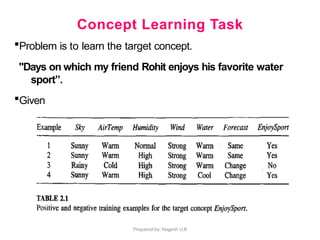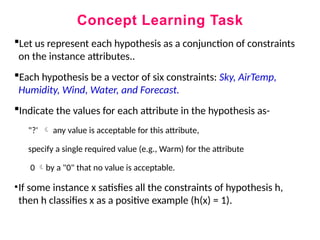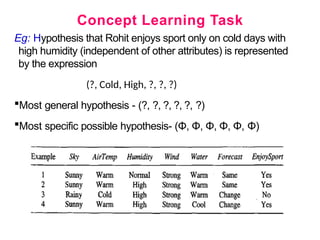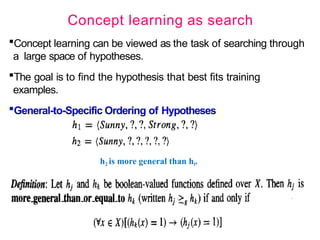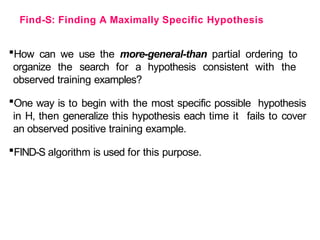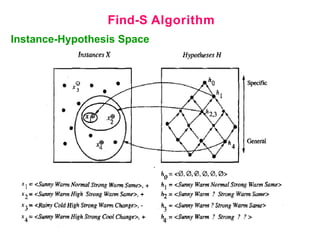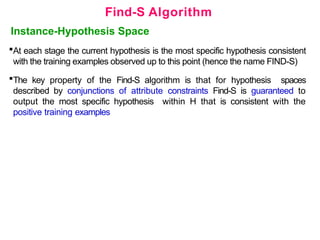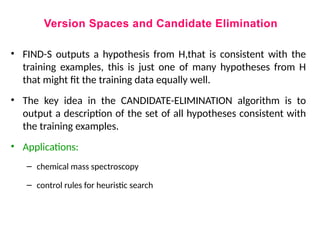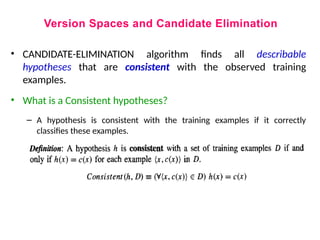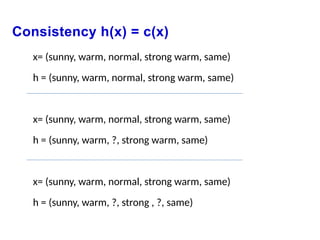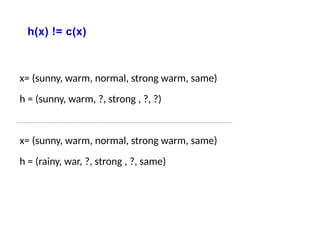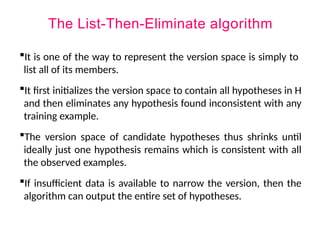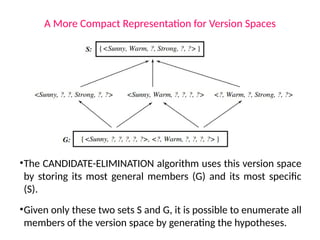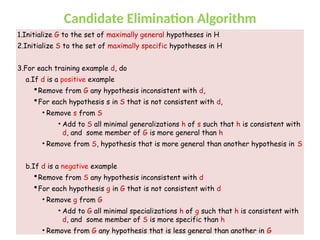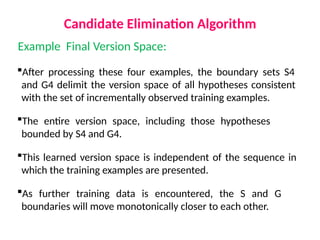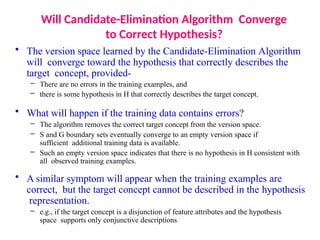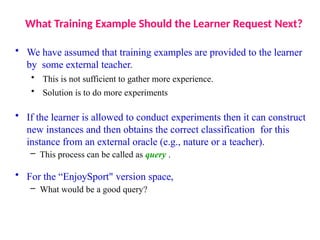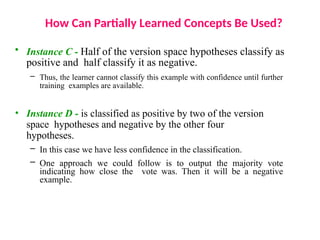General-to specific ordering of hypotheses Learning algorithms which use this ordering Version spaces and candidate elimination algorithm
- 1. MACHINE LEARNING 17CS73 7th Semester ISE By: Nagesh U.B Asst. Professor, Dept. of ISE , AIET
- 2. Prepared by: Nagesh U.B Chapter 1: Introduction Wellposedlearningproblems Designing a Learning system Perspective and Issues in Machine Learning Summary Chapter 2: Concept Learning Concept learning task Concept learning as search Find-S algorithm Version space Candidate Elimination algorithm Inductive Bias Summary Module 1- Outline
- 4. Prepared by: Nagesh U.B Concept Learning Inducing general functions from specific training examples is a main issue of machine learning. A task of acquiring a potential hypothesis (solution) that best fits the training examples It is the process of acquiring the definition of a general category from given sample positive and negative training examples of the category. Concept Learning can seen as a problem of searching through a predefined space of potential hypotheses for the hypothesis that best fits the training examples. Concept learning: Inferring a boolean-valued function from training examples of its input and output.
- 5. Prepared by: Nagesh U.B Concept Learning Task Hypothesis
- 6. Prepared by: Nagesh U.B Concept Learning Task Problem is to learn the target concept. "Days on which my friend Rohit enjoys his favorite water sport”. Given
- 7. Concept Learning Task Let us represent each hypothesis as a conjunction of constraints on the instance attributes.. Each hypothesis be a vector of six constraints: Sky, AirTemp, Humidity, Wind, Water, and Forecast. Indicate the values for each attribute in the hypothesis as- "?' any value is acceptable for this attribute, specify a single required value (e.g., Warm) for the attribute 0 by a "0" that no value is acceptable. •If some instance x satisfies all the constraints of hypothesis h, then h classifies x as a positive example (h(x) = 1).
- 8. Concept Learning Task Eg: Hypothesis that Rohit enjoys sport only on cold days with high humidity (independent of other attributes) is represented by the expression (?, Cold, High, ?, ?, ?) Most general hypothesis - (?, ?, ?, ?, ?, ?) Most specific possible hypothesis- (Φ, Φ, Φ, Φ, Φ, Φ)
- 9. Concept Learning Task Notations to represent Hypothesis
- 10. Concept Learning Task Notations to represent Hypothesis Training examples are represented as an instance x from X, along and its target concept value c(x). Instances for which c(x) = 1 are called positive examples. Instances for which c(x) = 0 are called negative examples. Therefore we write the ordered pair as: (x, c(x)) Then, each hypothesis h in H is: , h : X {O, 1} Now the goal of the learner is to find a hypothesis h such that h(x) = c(x) for all x in X where c(x) is the concept(0/1)
- 11. Inductive learning hypothesis Our assumption is that the Fundamental assumption of inductive learning. • “Best hypothesis regarding unseen instances is the hypothesis that best fits the observed training data.” The inductive learning hypothesis. • Any hypothesis found to approximate the target function well over a sufficiently large set of training examples will also approximate the target function well over other unobserved examples.
- 12. Concept learning as search Concept learning can be viewed as the task of searching through a large space of hypotheses. The goal is to find the hypothesis that best fits training examples. General-to-Specific Ordering of Hypotheses h2 is more general than hl.
- 13. Concept learning as search
- 14. Find-S: Finding A Maximally Specific Hypothesis How can we use the more-general-than partial ordering to organize the search for a hypothesis consistent with the observed training examples? One way is to begin with the most specific possible hypothesis in H, then generalize this hypothesis each time it fails to cover an observed positive training example. FIND-S algorithm is used for this purpose.
- 15. Find-S: Finding A Maximally Specific Hypothesis How can we use the more-general-than partial ordering to organize the search for a hypothesis consistent with the observed training examples? One way is to begin with the most specific possible hypothesis in H, then generalize this hypothesis each time it fails to cover an observed positive training example. FIND-S algorithm is used for this purpose.
- 16. Find-S Algorithm To Find Maximally Specific Hypothesis: 1. Initialize h to the most specific hypothesis in H 2. For each positive training instance x • For each attribute constraint ai in h •If the constraint ai is satisfied by x then do nothing •Else replace ai in h by the next more general constraint that is satisfied by x 3. Output Hypothesis h
- 17. Find-S Algorithm Illustration Consider the sequence of training examples from EnjoySport task. 1. Initialize h to the most specific hypothesis in H, i.e h (Φ, Φ, Φ, Φ, Φ, Φ) ………………h1 2. Upon observing the first training example which a positive example, it is clear that hypothesis (h1) is too specific as none of the " Φ " constraints in h1 are satisfied by this example. Therefore replace each constraint by the next more general constraint that fits the example. i.e h (Sunny, Warm, Normal, Strong, Warm, Same) …..h2
- 18. Find-S Algorithm 3. The second training example (also positive case) forces the algorithm to further generalize. Therefore substitute a ‘’?’’ in place of any attribute value in h that is not satisfied by the new example. i.e. h (Sunny, Warm, ?, Strong, Warm, Same) …h3 4. The third training example is a training negative example. So the algorithm makes no change to h. Therefore the current hypothesis h is the most specific hypothesis in H consistent with the observed positive examples.
- 19. Find-S Algorithm 5. The fourth training example (a positive case) leads to a further generalization of h. Therefore substitute a ‘’?’’ in place of any attribute value in h that is not satisfied by the new example. i.e h (Sunny, Warm, ?, Strong, ?, ?) …….h5
- 21. Find-S Algorithm Instance-Hypothesis Space FIND-S algorithm illustrates the more_general_than partial ordering to organize the search for an acceptable hypothesis. The search moves from most specific to progressively more general hypotheses along one chain of the partial ordering as shown below.
- 23. Find-S Algorithm Instance-Hypothesis Space At each stage the current hypothesis is the most specific hypothesis consistent with the training examples observed up to this point (hence the name FIND-S) The key property of the Find-S algorithm is that for hypothesis spaces described by conjunctions of attribute constraints Find-S is guaranteed to output the most specific hypothesis within H that is consistent with the positive training examples
- 24. Find-S Algorithm Find-S Drawbacks: •Questions still left unanswered Has the learner converged to the correct target concept? It has no way to determine whether it has found the only hypothesis in H consistent with the data (i.e., the correct target concept), or whether there are many other consistent hypotheses as well. Why prefer the most specific hypothesis? If multiple hypotheses consistent with the training examples, FIND- S will find the most specific. It is unclear whether we should prefer this hypothesis over the most general.
- 25. Find-S Algorithm Find-S Drawbacks: •Questions still left unanswered Are the training examples consistent? – Training examples may contain at least some errors or noise. Such inconsistent sets of training examples can severely mislead FIND-S, since it ignores negative examples. – Algorithm should detect when the training data is inconsistent and errors What if there are several maximally specific consistent hypotheses? – There can be several maximally specific hypotheses consistent with the data. Find S finds only one. – It should allow to backtrack on its choices of how to generalize the hypothesis that the target concept lies along a different branch of the partial ordering than the branch it has selected.
- 26. Version Spaces and Candidate Elimination • FIND-S outputs a hypothesis from H,that is consistent with the training examples, this is just one of many hypotheses from H that might fit the training data equally well. • The key idea in the CANDIDATE-ELIMINATION algorithm is to output a description of the set of all hypotheses consistent with the training examples. • Applications: – chemical mass spectroscopy – control rules for heuristic search
- 27. Version Spaces and Candidate Elimination • CANDIDATE-ELIMINATION algorithm finds all describable hypotheses that are consistent with the observed training examples. • What is a Consistent hypotheses? – A hypothesis is consistent with the training examples if it correctly classifies these examples.
- 28. Version Spaces and Candidate Elimination Notice the key difference between this definition of consistent and our earlier definition of satisfies. An example x is said to satisfy hypothesis h when h(x) = 1, regardless of whether x is a positive or negative example of the target concept. However, whether such an example is consistent with h depends on the target concept, and in particular, whether h(x) = c(x).
- 29. Version Spaces and Candidate Elimination CANDIDATE-ELIMINATION algorithm represents the set of all hypotheses which are consistent with the observed training examples. This subset of all hypotheses is called the version space with respect to the hypothesis space H and the training examples D,
- 30. Consistency h(x) = c(x) x= (sunny, warm, normal, strong warm, same) h = (sunny, warm, normal, strong warm, same) x= (sunny, warm, normal, strong warm, same) h = (sunny, warm, ?, strong warm, same) x= (sunny, warm, normal, strong warm, same) h = (sunny, warm, ?, strong , ?, same)
- 31. h(x) != c(x) x= (sunny, warm, normal, strong warm, same) h = (sunny, warm, ?, strong , ?, ?) x= (sunny, warm, normal, strong warm, same) h = (rainy, war, ?, strong , ?, same)
- 32. The List-Then-Eliminate algorithm It is one of the way to represent the version space is simply to list all of its members. It first initializes the version space to contain all hypotheses in H and then eliminates any hypothesis found inconsistent with any training example. The version space of candidate hypotheses thus shrinks until ideally just one hypothesis remains which is consistent with all the observed examples. If insufficient data is available to narrow the version, then the algorithm can output the entire set of hypotheses.
- 34. A More Compact Representation for Version Spaces •The CANDIDATE-ELIMINATION algorithm works o LIST-THEN- ELIMINATE algorithm, However the version space is represented by most general and least general members boundary sets that delimit the version space. Example: consider Enjoysport concept learning problem •FIND-S has given the hypothesis as: h = (Sunny, Warm, ?, Strong, ?, ?) •This is just one of six different hypotheses from H that are consistent with these training examples. •The other six hypotheses are-
- 35. A More Compact Representation for Version Spaces •The CANDIDATE-ELIMINATION algorithm uses this version space by storing its most general members (G) and its most specific (S). •Given only these two sets S and G, it is possible to enumerate all members of the version space by generating the hypotheses.
- 36. Definition for G and S •Therefore, version space = set of hypotheses contained in G + set of hypotheses contained in S + hypotheses that lie between G and S in the partially ordered hypothesis space
- 37. Definition for G and S Version space representation theorem:
- 38. Candidate Elimination Algorithm •The CEA computes the version space containing all hypotheses from H that are consistent with an observed sequence of training examples. •It begins by initializing the version space to the set of all hypotheses in H; that is, G-most general hypothesis in H and initializing the S boundary set to contain the most specific (least general) hypothesis
- 39. Candidate Elimination Algorithm 1.Initialize G to the set of maximally general hypotheses in H 2.Initialize S to the set of maximally specific hypotheses in H 3.For each training example d, do a.If d is a positive example Remove from G any hypothesis inconsistent with d, For each hypothesis s in S that is not consistent with d, • Remove s from S • Add to S all minimal generalizations h of s such that h is consistent with d, and some member of G is more general than h • Remove from S, hypothesis that is more general than another hypothesis in S b.If d is a negative example Remove from S any hypothesis inconsistent with d For each hypothesis g in G that is not consistent with d • Remove g from G • Add to G all minimal specializations h of g such that h is consistent with d, and some member of S is more specific than h • Remove from G any hypothesis that is less general than another in G
- 46. Candidate Elimination Algorithm Illustration The final version space for the EnjoySport concept learning problem
- 47. Candidate Elimination Algorithm Example Final Version Space: After processing these four examples, the boundary sets S4 and G4 delimit the version space of all hypotheses consistent with the set of incrementally observed training examples. The entire version space, including those hypotheses bounded by S4 and G4. This learned version space is independent of the sequence in which the training examples are presented. As further training data is encountered, the S and G boundaries will move monotonically closer to each other.
- 48. Will Candidate-Elimination Algorithm Converge to Correct Hypothesis? • The version space learned by the Candidate-Elimination Algorithm will converge toward the hypothesis that correctly describes the target concept, provided- – There are no errors in the training examples, and – there is some hypothesis in H that correctly describes the target concept. • What will happen if the training data contains errors? – The algorithm removes the correct target concept from the version space. – S and G boundary sets eventually converge to an empty version space if sufficient additional training data is available. – Such an empty version space indicates that there is no hypothesis in H consistent with all observed training examples. • A similar symptom will appear when the training examples are correct, but the target concept cannot be described in the hypothesis representation. – e.g., if the target concept is a disjunction of feature attributes and the hypothesis space supports only conjunctive descriptions
- 49. What Training Example Should the Learner Request Next? • We have assumed that training examples are provided to the learner by some external teacher. • This is not sufficient to gather more experience. • Solution is to do more experiments • If the learner is allowed to conduct experiments then it can construct new instances and then obtains the correct classification for this instance from an external oracle (e.g., nature or a teacher). – This process can be called as query . • For the “EnjoySport" version space, – What would be a good query?
- 50. What Training Example Should the Learner Request Next? • The learner should try to discriminate among the alternative competing hypotheses in its current version space. – It should choose an instance that would be classified positive by some of these hypotheses, but negative by others. – Example: <Sunny, Warm, Normal, Light, Warm, Same> – This instance satisfies three of the six hypotheses in the current version space . – If the trainer classifies this as positive example, the S boundary of the version space can then be generalized and is a negative example, the G boundary can then be specialized. • In general, the optimal query strategy for a concept learner is to generate instances that satisfy exactly half the hypotheses in the current version space. • Then the size of the version space is reduces by half with each new example, • Therefore the total number of experiments needed to reach correct target concept is: log2 |VS|
- 51. How Can Partially Learned Concepts Be Used? • The indication of multiple hypotheses in version space is the target concept has not yet been fully learned (partially learned). • But it is still possible to classify certain new examples as if the target concept had been uniquely identified. How it is possible??? • Considering the followings new instances to be classified:
- 52. How Can Partially Learned Concepts Be Used? Instance A - is classified as a positive instance by every hypothesis in the current version space. – Since all the hypotheses in the version space classified this as a positive instance, the learner can classify instance A as if it had already converged to correct target concept. • Instance B – is classified as a negative instance by every hypothesis in the version space. – This instance can therefore be safely classified as negative using our partially learned concept.
- 53. How Can Partially Learned Concepts Be Used? • Instance C - Half of the version space hypotheses classify as positive and half classify it as negative. – Thus, the learner cannot classify this example with confidence until further training examples are available. • Instance D - is classified as positive by two of the version space hypotheses and negative by the other four hypotheses. – In this case we have less confidence in the classification. – One approach we could follow is to output the majority vote indicating how close the vote was. Then it will be a negative example.
- 54. Inductive Bias • The CEA will converge to correct target concept only if it is given with accurate training examples and its initial hypothesis space contains the target concept. • What if the target concept is not contained in the hypothesis space? • Can we avoid this difficulty by using a hypothesis space that contains every possible hypothesis? • How does the size of this hypothesis space influence the ability of the algorithm to generalize to unobserved instances? • How does the size of the hypothesis space influence the number of training examples that must be observed? Fundamental Questions for Inductive Inference
- 55. Inductive Bias - A Biased Hypothesis Space • In EnjoySport example, we restricted the hypothesis space to include only conjunctions of attribute values. – Because of this restriction, the hypothesis space is unable to represent even simple disjunctive target concepts such as "Sky = Sunny or Sky = Cloudy." • From first two examples S2 : <?, Warm, Normal, Strong, Cool, Change> • This is inconsistent with third examples, and there are no hypotheses consistent with these three examples PROBLEM: We have biased the learner to consider only conjunctive hypotheses. We require a more expressive hypothesis space.
- 56. Inductive Bias • The solution to this problem is to have a hypothesis space capable of representing every teachable concept. – So we need every possible instance. – Every possible subset of the instances X is called as power set of X. • What is the size of the hypothesis space H (the power set of X) ? – In EnjoySport, the size of the instance space X is 96. – The size of the power set of X is 2|X| The size of H is 296 Note:- Our conjunctive hypothesis space is able to represent only 973 of these hypotheses. Therefore it is a very biased hypothesis space An Unbiased Learner
- 57. Inductive Bias • Let the hypothesis space H to be the power set of X. – A hypothesis can be represented with disjunctions, conjunctions, and negations of our earlier hypotheses. – The target concept "Sky = Sunny or Sky = Cloudy" could then be described as- <Sunny, ?, ?, ?, ?, ?> <Cloudy, ?, ?, ?, ?, ?> NEW PROBLEM: Our concept learning algorithm is now completely unable to generalize beyond the observed examples. Ex: suppose we present three positive examples (xl, x2, x3) and two negative examples (x4, x5) to the learner. Then- S : { x1 x2 x3 }and G : { (x4 x5) } NO GENERALIZATION – Therefore, the only examples that will be unambiguously classified by S and G are the observed training examples themselves. An Unbiased Learner continued..
- 58. Inductive Bias • Fundamental Property of Inductive Inference is: “A learner that makes no a priori assumptions regarding the identity of the target concept has no rational basis for classifying any unseen instances“ Inductive Leap: • A learner should be able to generalize training data using prior assumptions (B) in order to classify unseen instances. • The generalization is known as inductive leap and our prior assumptions are the inductive bias of the learner. • Inductive Bias (prior assumptions) of Candidate-Elimination Algorithm is that the target concept can be represented by a conjunction of attribute values, the target concept is contained in the hypothesis space and training examples are correct. The Futility of Bias free Learning:
- 59. Inductive Bias Consider a concept learning algorithm L for the set of instances X. • Let c be an arbitrary concept defined over X, and • let Dc = {<x , c(x)>} be an arbitrary set of training examples of c. • Let L(xi, Dc) denote the classification assigned to the instance xi by L After training on the data Dc. The inductive bias of L is any minimal set of assertions B such that for any target concept c and corresponding training examples Dc the following formula holds. Formal Definition
- 60. Inductive Bias – Three Learning Algorithms ROTE-LEARNER: Learning corresponds simply to storing each observed training example in memory. Subsequent instances are classified by looking them up in memory. If the instance is found in memory, the stored classification is returned. Otherwise, the system refuses to classify the new instance. Inductive Bias: No inductive bias CANDIDATE-ELIMINATION: New instances are classified only in the case where all members of the current version space agree on the classification. Otherwise, the system refuses to classify the new instance. Inductive Bias: the target concept can be represented in its hypothesis space. FIND-S: This algorithm, described earlier, finds the most specific hypothesis consistent with the training examples. It then uses this hypothesis to classify all subsequent instances. Inductive Bias: the target concept can be represented in its hypothesis space, and all instances are negative instances unless the opposite is entailed by its other know1edge.





